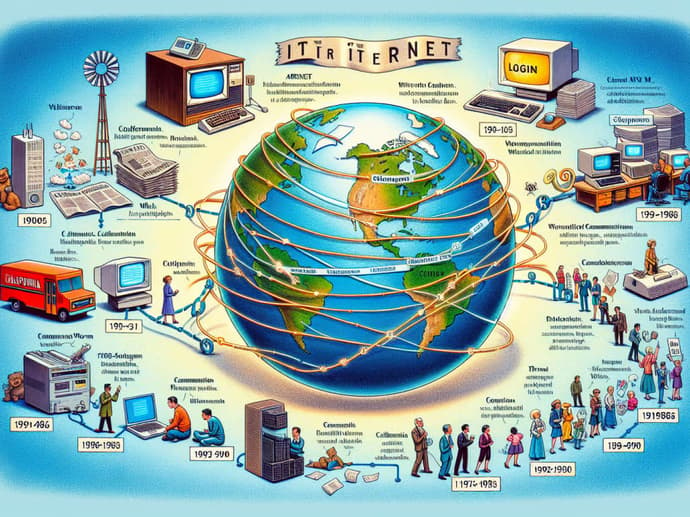A Brief History of the Internet: From Concept to Global Network

The internet is one of humanity’s greatest achievements, forever changing our way of life. Today, more than half of the world’s population creates and consumes information, uses messengers, scrolls through social networks, and shops online. However, the journey from early ideas to a global network was long and fascinating. Let’s trace this history.
The Foundations of the Internet
Like any great invention, the internet had its predecessors. In the early 20th century, scientists proposed creating a universal knowledge base. In 1910, the "Mundaneum" project emerged—a massive repository of newspapers, images, and other data accessible via telegraph or mail. This idea laid the groundwork for modern search engines.
As technology advanced, computers appeared in the mid-20th century. This spurred the development of the concept of connecting devices into a single network. American scientist Joseph Licklider introduced the idea of a "Galactic Network," where computers could share information.
ARPANET — The Dawn of a New Era
In the 1960s, the U.S. Advanced Research Projects Agency (ARPA) became interested in creating a reliable network. In 1969, ARPANET, the first computer network, was launched, connecting the University of California and Stanford. On October 29, 1969, the first word, "LOGIN," was transmitted between computers. Although the attempt didn’t succeed immediately, this day marked the beginning of the internet’s development.
A few years later, email appeared on the network, and the "@" symbol became an international standard for addressing messages. Interestingly, different countries have unique names for it, such as "monkey" in Germany or "ear" in Italy.
Standardization and Network Expansion
As more computers joined the network, the need for standardization grew. In 1983, the TCP/IP protocol was introduced, which remains in use today. It enabled data exchange between different networks, creating a unified infrastructure—the internet.
To simplify navigation, domain names and unique site addresses were introduced, making the internet more accessible and user-friendly.
Early Internet Communities and Service Development
By the mid-1980s, the first virtual communities began to form. For example, NSFNET, a network created for scientific centers and universities, connected tens of thousands of computers by 1985.
As the internet gained popularity, commercial services began to flourish. Platforms for communication, work, and entertainment emerged. Among them were online casinos, which became a notable example of how technology created new leisure opportunities.
However, as the number of users grew, so did the risks. In 1988, the first virus—the Morris Worm—infected 10% of all computers on the network. This case marked the first legal action under laws against computer misuse.
The World Wide Web Revolution
A true breakthrough occurred in 1989 when Tim Berners-Lee developed the World Wide Web (WWW). Based on hypertext, it allowed users to easily navigate between pages using links. This innovation made the internet accessible to the masses, and by the early 1990s, the network was growing rapidly.
In the USSR, similar developments were underway. The "Welcome" network, launched in the late 1980s, became the foundation of the Russian internet, or Runet.
The Internet Today
After ARPANET was shut down in the early 1990s, the internet became public domain. Anyone could not only use the network but also create their own resources. This led to the emergence of numerous digital services—from online shopping and streaming platforms to educational programs and online casinos, attracting millions of users worldwide.
Since then, the internet has continued to grow at an unprecedented pace, with new technologies offering innovative solutions for both businesses and individuals.
Conclusion
The history of the internet is a testament to how ideas and technologies can transform the world. Today, we can’t imagine life without it, but it’s important to remember that the internet is still evolving. New challenges and achievements await, making the internet even more useful, secure, and accessible in the future.

Elen Stelmakh is a creative individual dedicated to advancing gaming culture through articles and visual design. As a full-time EGamersWorld author and designer for a gaming website, Elen not only creates content but also infuses it with energy and creativity.
 How To Complete A Toxic Trail in Arc Raiders: Step-by-Step GuideArc Raiders walkthrough for A Toxic Trail, detailing Dam Battlegrounds objectives, exact locations, and puzzle context from the Cold Snap update.
How To Complete A Toxic Trail in Arc Raiders: Step-by-Step GuideArc Raiders walkthrough for A Toxic Trail, detailing Dam Battlegrounds objectives, exact locations, and puzzle context from the Cold Snap update.
 How To Complete Paving the Way in Arc Raiders: Step-by-Step GuideA full Arc Raiders walkthrough covering Paving the Way, with clear steps, locations, and puzzle context from the Cold Snap update.
How To Complete Paving the Way in Arc Raiders: Step-by-Step GuideA full Arc Raiders walkthrough covering Paving the Way, with clear steps, locations, and puzzle context from the Cold Snap update.
 How To Complete The Clean Dream in Arc Raiders: Step-by-Step GuideArc Raiders walkthrough for The Clean Dream quest, covering Spaceport tunnels, Blue Gate Maintenance Bunker, and related puzzle systems.
How To Complete The Clean Dream in Arc Raiders: Step-by-Step GuideArc Raiders walkthrough for The Clean Dream quest, covering Spaceport tunnels, Blue Gate Maintenance Bunker, and related puzzle systems.
 How to Get Guitar in Arc Raiders - Solving Puzzle GuideHidden guitar puzzle solved in Arc Raiders. Find all red buttons, unlock the Buried City door, and claim the cosmetic instruments.
How to Get Guitar in Arc Raiders - Solving Puzzle GuideHidden guitar puzzle solved in Arc Raiders. Find all red buttons, unlock the Buried City door, and claim the cosmetic instruments.



